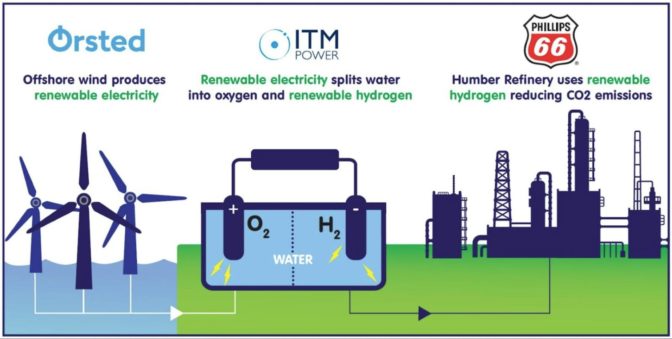Engineers are using the NVIDIA Omniverse 3D simulation platform as part of a proof of concept that promises to become a model for putting green energy to work around the world.
Dubbed Gigastack, the pilot project — led by a consortium that includes Phillips 66 and Denmark-based renewable energy company Ørsted — will create low-emission fuel for the energy company’s Humber refinery in England.
Hydrogen is expected to play a critical role as the world moves to reduce its dependence on fossil fuels over the coming years. The market for hydrogen fuel is predicted to grow over 45x to $90 billion by 2030, up from $1.8 billion today.
The Gigastack project aims to showcase how green energy can be woven into complex, industrial energy infrastructure on a massive scale and accelerate net-zero emissions progress.
To make that happen, new kinds of collaboration are vital, explained Ahsan Yousufzai, global head of business development for energy surface at NVIDIA, during a conversation about the project in an on-demand panel discussion at NVIDIA GTC.
“To meet global sustainability targets, the entire energy ecosystem needs to work together,” Yousufzai said. “For that, technologies like AI and digital twins will play a major role.”
The system — now in the planning stages — will draw power from Ørsted’s massive Hornsea 1,218-megawatt offshore wind farm, the largest in the world upon its completion in January last year.

Hornsea will be connected to ITM Power’s Gigastack electrolyzer facility, which will use electrolysis to turn water into clean, renewable hydrogen fuel.
That fuel, in turn, will be put to work at Phillips 66’s Humber refinery, decarbonizing one of the U.K.’s largest industrial facilities.
The project is unique because of its scale — with plans to eventually ramp up Gigastack into a massive 1-gigawatt electrolyzer system — and because of its potential to become a blueprint for deploying electrolyzer technology for wider decarbonization.
Weaving all these elements together, however, requires tight collaboration between team members from Element Energy, ITM Power, Ørsted, Phillips 66 and Worley.
Worley — one of the largest global providers of engineering and professional services to the oil, gas, mining, power and infrastructure industries — turned to Aspen Technology’s Aspen OptiPlant, sophisticated software that’s a workhouse for planning and optimizing some of the world’s most complex infrastructure.
“When you have a finite amount of money to be spent, you want to maximize the number of options on how facilities can be designed, fabricated and constructed,” explained Vishal Mehta, senior vice president at Worley.
“This is the importance of rapid optioneering, where you’re able to run AI models and engines with not only mathematics but also visual representation,” Mehta said. “People can come up with ideas and, in real time, move them around with mathematical equations changing in the background.”
Worley relied on AspenTech’s OptiPlant to develop a 3D conceptual layout of the Gigastack green hydrogen project. The industrial optimization software combines decades of process modeling expertise with cutting-edge AI and machine learning.
The next step: connecting OptiPlant’s sophisticated physics-based plant piping and layout capabilities to build a 3D conceptual layout of the plant with Omniverse, potentially allowing teams to work together on plant design in real-time — connecting their various 3D software tools, datasets and teams together.
“With a traditional model review, it’s one person leading the way, but here we have this opportunity for everybody to be immersed in the facility,” said Sonali Singh, vice president of product management for performance engineering at AspenTech. “They can really all collaborate by looking at their individual priorities.”
Omniverse can be the platform on which they further build their digital twin of the growing facility, enabling connection of simulation data and AIs, capturing knowledge from human and AI collaborators working on the project and bringing intelligent optimization.
To learn more, watch the on-demand GTC session and explore the Gigastack project.
Find out how Siemens Gamesa and Zenotech are accelerating offshore wind farm simulations with NVIDIA’s full-stack technologies. Discover how AI is powering the future of clean energy.